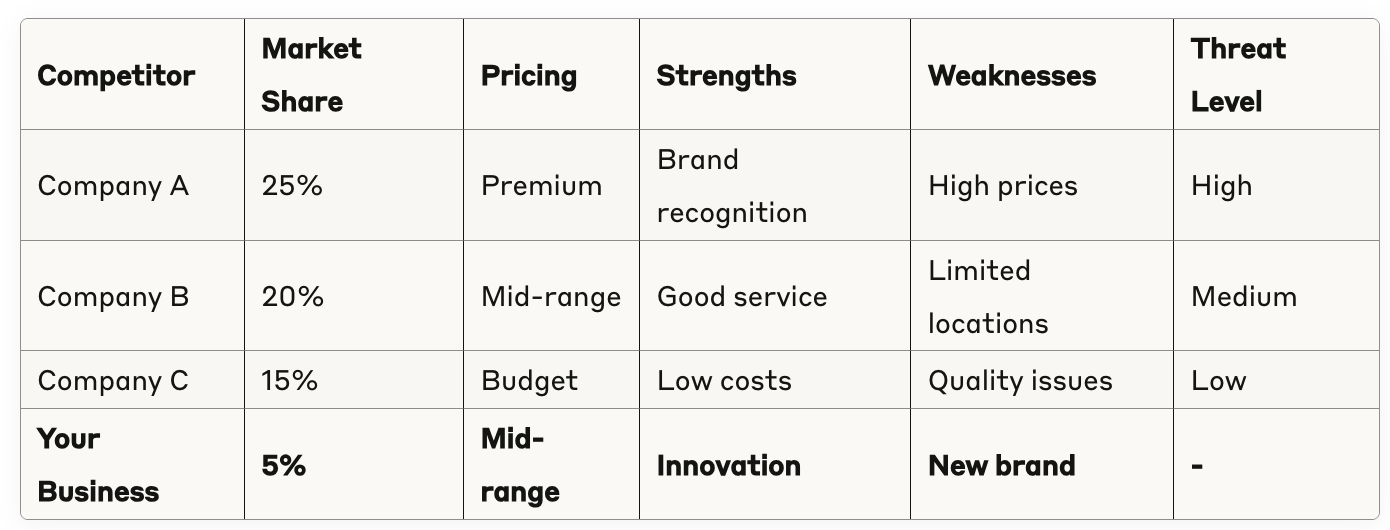
Published: July 2025
Creating a comprehensive business plan is one of the most critical steps for any Australian entrepreneur or small business owner. Whether you're seeking funding, applying for government grants, or simply mapping out your business strategy, a well-crafted business plan serves as your roadmap to success. This guide provides you with everything you need to create a professional business plan tailored specifically for the Australian market.
A business plan is far more than a document required by banks or investors. According to the Australian Small Business and Family Enterprise Ombudsman, businesses with formal business plans are 30% more likely to achieve growth compared to those without. In Australia's competitive market, where approximately 60% of small businesses fail within the first three years, having a solid business plan significantly improves your chances of success.
Australian businesses face unique challenges including regulatory compliance, seasonal market variations, and competition from both domestic and international players. A localised business plan addresses these specific challenges while capitalising on opportunities within the Australian market.
Before diving into your business plan template, it's essential to understand the current Australian business landscape. The Australian Bureau of Statistics reports that there are over 2.5 million actively trading businesses in Australia, with 97% classified as small businesses employing fewer than 20 people.
The Australian economy is characterised by strong service sectors, robust mining and resources industries, and growing technology sectors. Key considerations for Australian businesses include:
Your executive summary is the first impression investors and stakeholders will have of your business. This section should be compelling, concise, and capture the essence of your entire business plan in 1-2 pages. Include your business concept, target market, competitive advantages, financial highlights, and funding requirements.
Key Elements:
This section provides detailed information about your business, including its legal structure, location, and the problems it solves. For Australian businesses, ensure you specify your business structure (sole trader, partnership, company, or trust) and include relevant Australian Business Number (ABN) and Australian Company Number (ACN) details.
Describe your business's mission, vision, and values. Explain how your business fits into the current market and what makes it unique. Include information about your business's history, ownership structure, and legal considerations specific to Australian operations.
Thorough market research is crucial for Australian businesses. This section should demonstrate your understanding of your industry, target market, and competitive landscape within Australia. Include both primary and secondary research data.
Industry Analysis:
Target Market Analysis:
Understanding your competition is vital in Australia's diverse market. Identify direct and indirect competitors, analyse their strengths and weaknesses, and position your business accordingly.
Create a competitive analysis that includes:
Detail your business's organisational structure, including key personnel, their roles, and qualifications. For Australian businesses, include information about advisory boards, mentors, and any professional services providers such as accountants, lawyers, or business advisors.
Highlight the experience and expertise of your management team, particularly their knowledge of the Australian market. Include organisational charts, job descriptions, and personnel plans for future growth.
Provide comprehensive details about your products or services. Explain how they benefit customers and what lifecycle stage they're in. Include information about research and development activities, intellectual property considerations, and any unique features or benefits.
For Australian businesses, consider:
Your marketing and sales strategy should be tailored to the Australian market, considering local preferences, cultural nuances, and regulatory requirements. Outline how you'll attract and retain customers in the competitive Australian landscape.
Marketing Strategy Elements:
Sales Strategy:
Financial projections are arguably the most critical component of your business plan. Australian businesses must present realistic, well-researched financial forecasts that demonstrate viability and growth potential.
Essential Financial Statements:
Financial Assumptions:
If you're seeking funding, clearly outline your funding requirements, how you'll use the funds, and the type of funding you're seeking. Australian businesses have access to various funding sources including:
Specify the amount needed, the timeframe for funding, and how the investment will generate returns for stakeholders.




Australian retail businesses must consider seasonal variations, with peak trading periods during Christmas, Easter, and back-to-school seasons. Online businesses must comply with Australian Consumer Law, including clear return policies and delivery timeframes.
Service-based businesses in Australia often face regulatory requirements such as professional licensing, insurance obligations, and continuing education requirements. Consider these ongoing costs in your financial projections.
Australian manufacturers must comply with workplace safety regulations, environmental standards, and quality certifications. Include compliance costs and potential export opportunities in your business plan.
Tech businesses in Australia benefit from government incentives such as the R&D Tax Incentive and various startup grants. Include these opportunities in your funding strategy.
The Australian government provides numerous support programs for small and medium businesses. These include:
Federal Government Programs:
State and Territory Programs:
When preparing your business plan, research relevant grant opportunities and include potential government funding in your financial projections.
Many Australian businesses fail because they create unrealistic financial projections. Base your assumptions on solid market research and include conservative scenarios in your planning.
Don't underestimate the importance of thorough market research. Australian markets can be highly localised, and what works in Sydney may not work in Perth or Darwin.
Australia has complex regulatory environments that vary by state and industry. Ensure your business plan addresses all relevant compliance requirements and associated costs.
Cash flow problems are a leading cause of business failure in Australia. Create detailed cash flow projections and include contingency plans for slower periods.
A business plan is a living document that should be regularly reviewed and updated. Establish a review schedule to assess performance against projections and adjust strategies as needed.
Monthly Reviews:
Quarterly Reviews:
Annual Reviews:
Australian businesses increasingly need to embrace digital transformation to remain competitive. Include technology initiatives in your business plan, such as:
The Australian government's Digital Business Plan provides resources and guidance for businesses looking to improve their digital capabilities.
Australian consumers and businesses increasingly value sustainability. Include environmental considerations in your business plan, such as:
These initiatives can provide competitive advantages and access to green funding opportunities.
Australian businesses face various risks including natural disasters, economic downturns, and regulatory changes. Your business plan should include:
Risk Assessment:
Business Continuity Planning:
Establish clear metrics to measure your business's success. Australian businesses should track both financial and non-financial indicators:
Financial KPIs:
Non-Financial KPIs:
Creating a comprehensive business plan is essential for success in the Australian market. This template provides the framework you need to develop a professional, well-researched business plan that will help you secure funding, guide your operations, and achieve your business goals.
Remember that your business plan should be tailored to your specific industry, target market, and business model. Use this template as a starting point, but customise it to reflect your unique value proposition and market opportunities.
Regular review and updates ensure your business plan remains relevant and useful as your business grows and market conditions change. With a solid business plan in place, you'll be well-positioned to navigate the challenges and opportunities of the Australian business environment.
A business plan template is a pre-formatted document that provides the structure and guidance needed to create a comprehensive business plan. It includes all essential sections such as executive summary, market analysis, financial projections, and marketing strategy, with prompts and examples to help you complete each section effectively.
An effective Australian business plan typically ranges from 20-40 pages, depending on the complexity of your business and intended audience. Executive summaries should be 1-2 pages, while detailed sections can vary in length based on your specific needs and industry requirements.
Australian business plans should include profit and loss statements, cash flow projections, balance sheets, break-even analysis, and key financial ratios. Include 3-5 year projections with monthly detail for the first year, and ensure all figures comply with Australian accounting standards and GST requirements.
While the core business plan structure remains consistent across Australia, you may need to adjust certain sections based on state-specific regulations, licensing requirements, and market conditions. Research your state's specific business requirements and include relevant compliance information in your plan.
Review your business plan monthly for cash flow and performance tracking, quarterly for strategic assessments, and annually for comprehensive updates. Major changes in market conditions, business operations, or strategic direction should trigger immediate plan updates.
The Australian government offers various resources including the Business.gov.au website, free business planning tools, mentoring programs, and grants for business development. Many states also provide specific support programs and funding opportunities for new and growing businesses.
Conduct market research using Australian Bureau of Statistics data, industry reports, competitor analysis, customer surveys, and focus groups. Utilise resources like IBISWorld, Roy Morgan Research, and government industry publications to gather relevant Australian market data.
Australian investors look for realistic financial projections, clear market opportunities, experienced management teams, scalable business models, and strong competitive advantages. Include local market knowledge, regulatory compliance awareness, and growth potential within the Australian context.
While you can create an effective business plan yourself using templates and resources, consider professional help if you're seeking significant funding, entering complex industries, or lack business planning experience. Many Australian business advisors and consultants specialise in business plan development.
Include confidentiality statements in your business plan, limit distribution to serious stakeholders, use non-disclosure agreements when sharing sensitive information, and consider registering trademarks or patents for unique ideas. Keep detailed records of who receives copies of your plan and when.
Common failures include unrealistic financial projections, insufficient market research, inadequate cash flow planning, ignoring regulatory requirements, poor competitive analysis, and lack of regular updates. Avoid these pitfalls by conducting thorough research, using conservative assumptions, and maintaining regular plan reviews.
Yes, many Australian government grants require a comprehensive business plan as part of the application process. Ensure your plan addresses specific grant criteria, demonstrates how funding will be used, and shows potential for job creation, innovation, or economic development as relevant to the grant program.
Scale Suite delivers embedded finance and human resource services for ambitious Australian businesses.Our Sydney-based team integrates with your daily operations through a shared platform, working like part of your internal staff but with senior-level expertise. From complete bookkeeping to strategic CFO insights, we deliver better outcomes than a single hire - without the recruitment risk, training time, or full-time salary commitment.
Considering hiring finance staff? Let's compare what you'd get with an internal hire versus our embedded team approach.
Our experts will show you the complete picture - costs, capabilities, and flexibility - so you can make the right decision for your business.
No lock-in contracts and 30 day money back guarantee.



